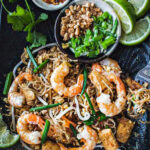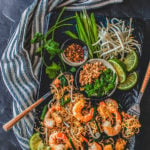Description
Pad Thai is Thailand’s most famous Thai noodle dish outside of Thailand. Today, I'm sharing the best and easy authentic shrimp Pad Thai recipe from my kitchen with you!
Ingredients
Pad Thai Sauce
- 4 tablespoons palm sugar (or 3 1/2 tablespoons brown sugar to substitute)
- 2 tablespoons fish sauce
- 2 1/2 tablespoons tamarind concentrate
- Mix all the sauces in a small bowl, zap in the microwave for 1 minute, stir well and set aside.
For the Pad Thai
- 12 oz soft/fresh Pad Thai noodles or 5 ounces dried rice noodles. See instructions for preparation notes.
- 5 tablespoons oil, divided
- 8 ounces raw shrimp, deveined, shell, and tails removed.
- 4 cloves garlic, roughly chopped
- 1 large shallot, thinly sliced. (Around 2 ounces)
- 2 tablespoons dried shrimp
- 1/2 ounce preserved or pickled radish, thinly sliced. See the image and ingredient notes above
- 3 ounces pressed firm tofu, deep fried, baked, or air-fried tofu, thinly sliced
- 2 eggs or 3 small ones, lightly whisk
- 1 1/2 cups bean sprouts. Save a small handful for garnishing
- ½ cup green onions, chopped into 1 1/2-inch piece
- 3 tablespoons crushed peanuts, divided. Save some for garnishing.
For Garnishing (as desired)
- Chili pepper flakes
- Crushed peanuts
- Granulated sugar
- Lime wedge
Instructions
- Prepare the noodles. Soak the noodles in a large bowl with water until soft. Drain, dab the noodles with paper towels to dry off excess water, then let sit until ready to use. If using packaged noodles, follow the instructions on the bag.
- Make the Pad Thai sauce in a small bowl using fish sauce, tamarind juice, and sugar. Zap in the microwave for 30-45 seconds, stir well and set aside.
- Heat a wok or large skill on medium-high heat, and add the oil. Once hot, add the shrimp and cook for 2 minutes or until the shrimp is lightly pink. Remove from the wok and set aside.
- Add 2 tablespoons of oil to the same wok, and reserve the rest for later. Wait for a few seconds, add garlic, shallots, dried shrimp, and pickled radish, and cook for 1-2 minutes or until fragrant and lightly golden brown. **This is where we're extracting ALOT of flavors from these ingredients! Plus, once lightly crispy, these ingredients truly elevate the flavors and texture of authentic Pad Thai even more.
- Add the sliced tofu and stir fry for just a minute, enough to slightly crisp the pieces in the wok. I like to add my tofu separately here because I like my tofu slightly crispy for the texture. You can add during step 4 above if preferred.
- Add the noodles and the Pad Thai sauce, stir well and cook for 1 minute until the noodles soften. Spread the noodles on the pan as much as possible to prevent them from getting too soggy.
- Push the noodles to the side of the wok, add the rest of the oil, then add the lightly whisked eggs and scramble lightly. 1 minute or so. You can also use the middle of the pan like you're making a volcano crater for the eggs if it's easier. Stir in the noodles, and leave the eggs in chunky pieces if possible for extra meatiness.
- Add the shrimp back in and the green onions. Stir well.
- Add most of the bean sprouts (save a handful for garnishing)and half of the crushed peanuts into the pan. Stir in very lightly. Turn the heat off and move the pan from the stovetop. Taste your freshly homemade Pad Thai and adjust the flavors using fish sauce, sugar, and fresh lime juice. Add some chili powder for spiciness
That's it! Plate your glorious creation, and garnish it with chili flakes, crushed peanuts, and sprouts. Share if you can, and enjoy your authentic shrimp Pad Thai!
Notes
- For the fresh Pad Thai noodles. If using fresh rice noodles, you still need to soak them in water for a little bit until the noodles are soft but still al dente. If possible, always pick fresh noodles. They are easier to work with, taste better, and cook quicker than dried rice sticks.
- If using dried noodles, prepare according to the package instructions for the best result. They will always need to be soaked in hot water until soft. Do not let the noodles get too soft, or your Pad Thai will stick together too mushy.
- For the tamarind sauce, you can make tamarind pulp or buy a pre-made jar at your local Asian market. This sour sauce is a common ingredient used in Thai cooking.
- The best way to make an authentic version of Pad Thai is to not skip out on fish sauce, preserved radish, dried shrimp, and tamarind pulp. The palm sugar can be substituted with brown sugar, but the others, I don't recommend substituting it Unless you want an easier and quicker version like this Easy beef Pad Thai.
- I sliced my preserved radish long rather than chop it small. Preserved radish is an acquired taste. The flavor can be strong if you are not used to it. Chop them small to start, and then play around with larger pieces as you are used to them.
- Another easy way to make the sauce, especially if using chunky palm sugar, is to combine the sauces in a saucepan over low heat until the sugar dissolves. Let cool while prepping other ingredients.
** Thank you so much for visiting my blog! This is truly a passion for me. If you have enjoyed these recipes and appreciate the hard work I put into them, I would love it if you would share them with your friends! Your recommendation is the highest review I could hope for, and I’d appreciate it! **
- Prep Time: 15
- Cook Time: 15
- Category: Noodles
- Method: Stir fry
- Cuisine: Thai
Keywords: authentic pad thai, easy pad thai, shrimp pad thai, authentic pad thai recipe, easy pad thai recipe, traditional pad thai recipe

